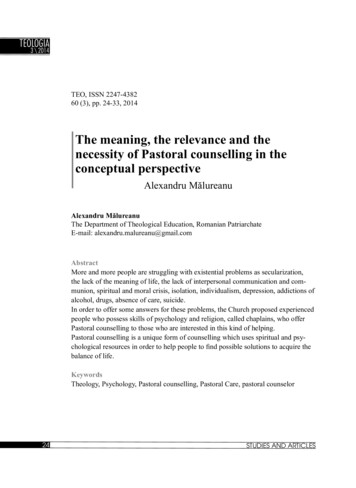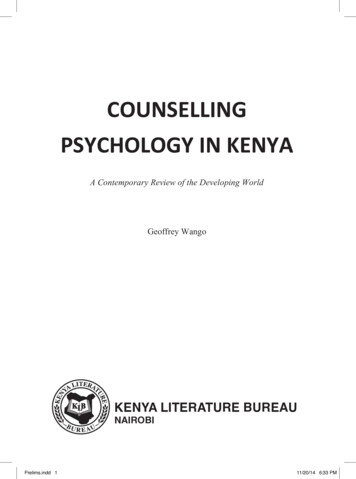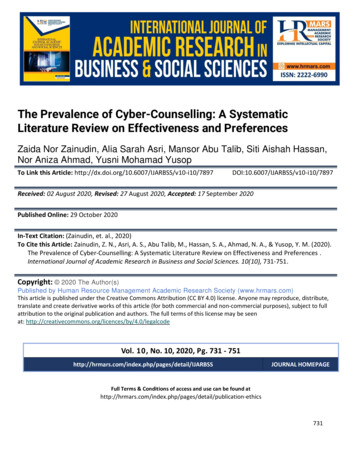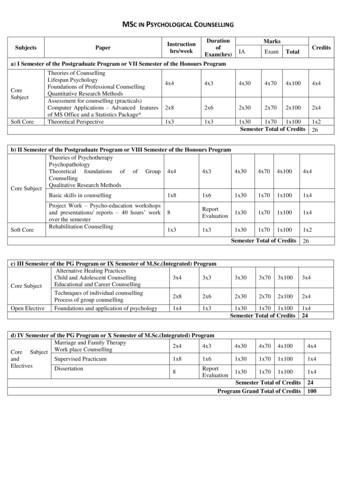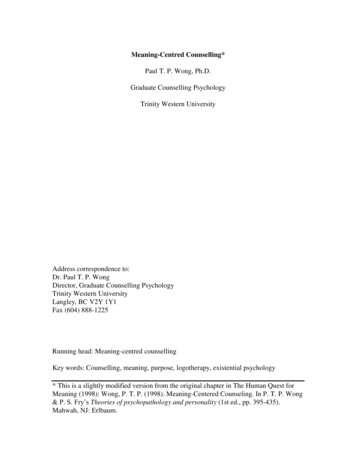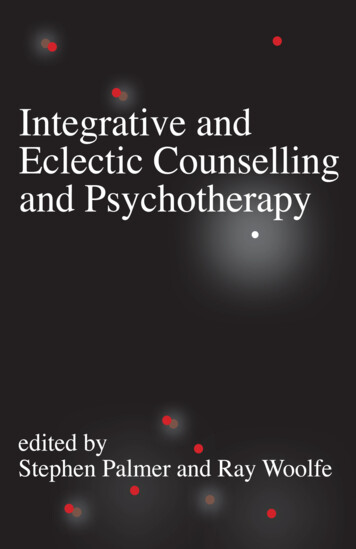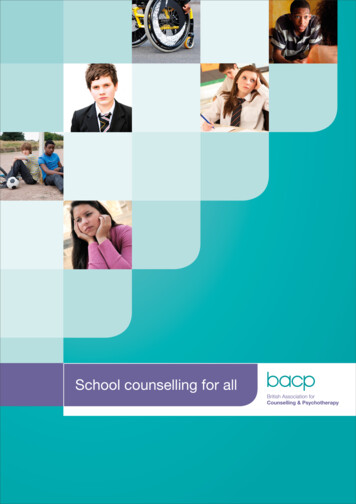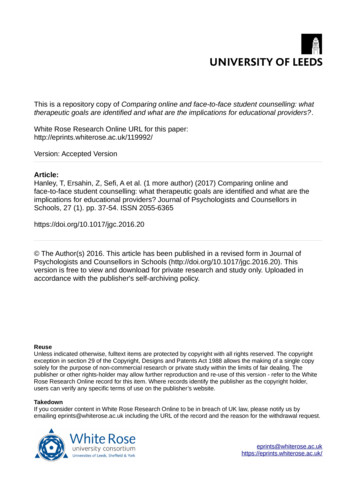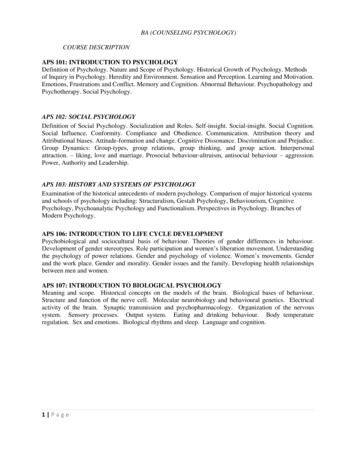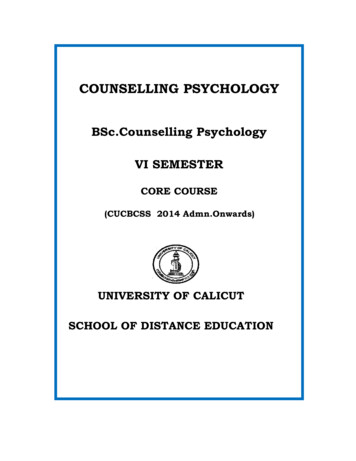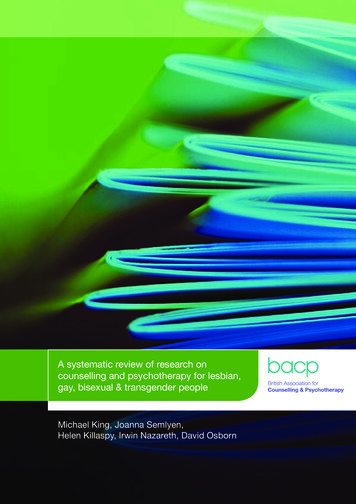
Transcription
A systematic review of research oncounselling and psychotherapy for lesbian,gay, bisexual & transgender peopleMichael King, Joanna Semlyen,Helen Killaspy, Irwin Nazareth, David Osborn
A systematic review of research on counselling and psychotherapy for lesbian, gay,bisexual and transgender people is published by the British Association for Counsellingand Psychotherapy, BACP House, 15 St John’s Business Park, Lutterworth,Leicestershire, LE17 4HB.t: 01455 883300f: 01455 550243e: bacp@bacp.co.ukw: www.bacp.co.ukBACP is the largest professional organisation for counselling and psychotherapy inthe UK, is a company limited by guarantee 2175320 in England and Wales, and aregistered charity, 298361. British Association for Counselling and Psychotherapy 2007First published April 2007.Michael King, Professor1,2; Joanna Semlyen, Research Fellow1; Helen Killaspy,Senior Lecturer1,2; Irwin Nazareth, Professor3,4; David Osborn, Senior Lecturer1,2Department of Mental Health Sciences, Royal Free and University College Medical School,Hampstead Campus, University College London, London NW3 2PF1Camden and Islington Mental Health and Social Care Trust, St Pancras Hospital, London NW1 0PE2Department of Primary Care and Population Sciences, Royal Free and University College MedicalSchool, Hampstead Campus, University College London, London N19 5LW3General Practice Research Network, Medical Research Council, 158-60 North Gower Street,London, NW1 2ND4Correspondence to:Professor Michael KingDepartment of Mental Health SciencesRoyal Free and University College Medical SchoolHampstead CampusUniversity College LondonLondon NW3 2PFe: m.king@medsch.ucl.ac.ukt: 020 7830 2397f: 020 7830 2808This publication is copyright under the Berne Convention and the Universal CopyrightConvention. All rights reserved. No part of this publication may be produced or transmittedin any form or by any means, including photocopying, microfilming, and recording, withoutthe written permission of the copyright holder, application for which should be addressedto the Chief Executive at BACP. Such written permission must always be obtained beforeany part of this publication is stored in a retrieval system of any nature, or electronically.ISBN: 1-905114-23-0ISBN: 13: 978-1-905114-21-4Price: 8.00 for BACP members, 10.00 for non-members, p&p free. Copies may beobtained from the Book Orders Department at BACP in Rugby at the address givenabove. Cheques should be made payable to BACP. The text is also downloadable fromthe BACP website, www.bacp.co.ukAcknowledgementsWe thank Rosalind Lai for her guidance and advice in developing the searchstrategy for this review, and Nika Fuchkan for assisting as a co-rater.
ContentsExecutive summaryPage 21.0BackgroundPage 42.0Research questionsPage 43.0ObjectivesPage 44.0MethodPage 45.0ResultsPage 66.0DiscussionPage 327.0RecommendationsPage 33List of figures and tables BACP 2007Figure 1: FlowchartPage 12Table 1:Description of the 14 studies withquantitative dataPage 13Table 2:Description of the 10 studies with qualitativedata including main themes arisingPage 26A systematic review of research on counselling and psychotherapy for lesbian, gay, bisexual & transgender people01
Executive summary Effectiveness within experimental or quasiexperimental designsBackgroundb) Qualitative studies of psychotherapy and counselling forLGBT people.Counselling and psychotherapy services for lesbian, gay andbisexual (LGB) people have developed against a historicalbackground of medical and psychological pathologisationof homosexuality over the past 130 years. Prejudice againsthomosexuality amongst therapists and the rest of society issimilar to prejudice against transgenderism, as, in contrastto discrimination against characteristics such as race or sex,both have been regarded as unnatural and morally perverse.Although a lesbian-, gay-, bisexual- and transgender(LGBT)affirmative strand of mental health services provision hasdeveloped over the last 20–30 years, particular areas of needfor knowledge and understanding remain to be addressed.These are: homosexuality as one of a range of acceptablesexual identities; LGBT people’s lifestyle, social networks andsupport systems; how sexuality and gender are understoodand responded to within families and cultures; the difficultiesof growing up LGBT, and how information and disclosureabout LGBT identity is managed; the coming-out process;the expertise and sensitivity of therapists to these issues;therapist sexual orientation and its relevance to the processand outcome of therapy; and the particular mental healthvulnerabilities and needs of LGBT people. Although there isevidence for effectiveness of psychotherapy, we know littleabout how talking therapies are provided for LGBT people, orthe effectiveness of such therapies within this group.We searched the following medical databases: Medline,Embase, PsycInfo, Cinahl, Cochrane Library Database, andthe Web of Knowledge; and the following social sciencedatabases: ASSIA (Applied Social Sciences Index andAbstracts), IBBS (International Bibliography of the SocialSciences), Sociological Abstracts, and The CampbellCollaboration. We restricted our search to 1966 onwards,as we considered it very unlikely that LGBT-affirmativepsychotherapy was prevalent to any significant extent beforethat year. We decided, at the tendering stage for this review,not to include papers on psychotherapy or counsellingthat formed part of, or were aimed at, successful genderreassignment. We considered that this lay outside our mainremit of psychotherapy and counselling services for LGBTpeople and that it had already been the subject of specificpublications. We were also concerned that to include suchstudies would mean a loss of focus on the lack of services forother issues in transgender people.Research questions1) What is the research evidence on the type and provisionof counselling and psychotherapy for LGBT people?2) What research measures have been applied to assessparticipation in, satisfaction with, and effectiveness ofthese interventions?3) Is there evidence on the effectiveness of counselling andpsychotherapy that is specifically affirmative of LGBTpeople?4) Can this evidence (a) identify implications for policy andpractice in this field, and (b) inform future priorities forresearch?ObjectivesTo undertake a systematic review of quantitative research anda thematic review of the qualitative literature in order to:a) Review existing research on counselling andpsychotherapy for LGBT people.b) Describe and evaluate the contribution of differentresearch measures, techniques and designs used in thisarea.c) Identify future priorities for policy, practice and research.MethodWe undertook a systematic search for:a) Quantitative studies of counselling or psychotherapy forLGBT people focusing on: The specific nature of therapies used in this group Research instruments used to assess effectivenessand client-centred satisfaction02We searched the following grey literature: Aslib Index toTheses; Dissertation Abstracts; and the ESRC website. Wealso reviewed the reference lists of each study and reviewpaper found, to ensure that no publications were missed. Wealso carried out a search on the Internet using the ‘Google’search engine. For the purposes of the literature search, weincluded papers where sexual orientation or transgenderwas examined as a variable. This included papers that: (1)considered self-identification as gay, lesbian, bisexual ortransgender; (2) used the terms ‘homosexual’ or ‘bisexual’and/or (3) made an assessment of same-sex attraction,fantasy, or behaviour; and/or (4) used the terms ‘genderidentity’, ‘transexualism’ or ‘transgender’. In the remainderof this report, we use the term LGBT to cover this rangeof definition. We screened the titles and abstracts of eachcitation and identified for full review any where there wasa possibility that the study met eligibility criteria A and Bdescribed above. Citations that lacked sufficient informationor did not have an abstract were retrieved in full text for furtherconsideration. To determine eligibility for inclusion of eachstudy/paper in the review, JS and colleagues, working in pairs,independently evaluated the articles retrieved. Disagreementswere resolved by consensus at steering-group meetings.ResultsFrom 7,775 citations identified in the electronic search, 92papers were obtained as potentially appropriate for the review.A further 18 potential papers were obtained for the review,identified from the grey literature, from hand searching ofjournals and reference lists, and from searching the Internetusing the Google search engine. Thus, 110 papers in allwere read and considered for inclusion, of which 22 paperswere eventually retained in the review. Fourteen providedquantitative data and 10 qualitative data; two paperscontained both quantitative and qualitative data. Therewere no trials evaluating the effectiveness of psychologicalinterventions in LGBT people, nor were there any longitudinalfollow-up studies of people who had received a specificservice or therapy. Two papers provided quantitative dataon transgender participants, but none provided qualitativedata for this group. For simplicity, however, we use theabbreviation LGBT and clarify when findings are specific toparticular sub-groups.A systematic review of research on counselling and psychotherapy for lesbian, gay, bisexual & transgender people BACP 2007
Quantitative reviewWe identified no randomised trials of effectiveness of generalor specialised mental health treatments for LGBT people.Nor did we identify any ‘before and after’ or cohort studiesassessing outcomes of therapy and counselling for LGBTpeople. There was no consistency in the instruments usedto assess past or current therapy, satisfaction with care orother outcomes. None of the studies reviewed measuredmental health outcomes using validated psychometricmeasures. Early studies showed that stress around beingLGBT often precipitated first contact with a therapist. Thisfinding was absent from most of the later studies, and thischange is likely to reflect a ‘period effect’ over these decadesas homosexuality has become more socially acceptable. Theoutcomes measured mainly concerned the client’s satisfactionwith the therapy and therapist, and the helpfulness of therapy.The majority were rated positively. Positive therapist attitudewas associated with positive experiences of therapy, andgreatest perceived benefits were reported by clients whenthere was matching in sexual orientation between client andtherapist. Recency of the therapy and a greater investmentof time in therapy were also associated with more positivereports of outcome. Any attempt to change sexual orientationwas judged very negatively and generally led to poorperceptions of therapy.Qualitative reviewOur principal findings were that therapists’ attitude,knowledge and practice are more important than their sexualorientation; that LGBT clients need to understand (andexamine) in the therapy their desire to seek or avoid an LGBTtherapist; and that therapists need to be aware of the realityand stereotypes of the LGBT world.The studies revealed that therapists cannot, and shouldnot, rely on being educated about LGBT cultures by theirclients. Firstly, they may simply fit in with whichever dominantdiscourse their clients subscribe to; secondly, it simply wastesthe client’s time; and thirdly, it may make clients feel odd andmisunderstood. Both therapist and client need to be aware ofthe dominant discourses and stereotypes in the LGBT world,because, if they fail to do so, the possibility of collusion andshared assumptions may limit the depth and utility of thetherapy. Adequate knowledge usually led to fewer biasedattitudes and fewer heteronormative assumptions on the partof (LGBT or non-LGBT) therapists. Therapists need to be freeof anti-homosexual bias, and that requires careful attentionto their own psychological function, training, knowledgeand experience, and therapeutic relationship with eachpatient. There appears to be no simple rule for therapistsabout whether to disclose their own LGBT or heterosexualidentification. Findings on whether or not LGBT clients preferan LGBT therapist were very mixed, and there is probably nooverall conclusion to make. If anything, it would appear thatthis was of greatest importance to lesbians.1) All psychotherapy training institutes regard knowledge ofLGBT development and lifestyles as part of core training.a. Heteronormative bias must be recognised andavoided.b. Therapists should increase their knowledge of LGBTissues and keep up to date.c. Psychotherapeutic practice that pathologiseshomosexuality, bisexuality and transgenderism shouldbe replaced by more modern understandings ofsexual identity.d. Therapists should become aware of internalised biasin the LGBT clients themselves.e. Therapists should receive training on the impact of selfdisclosure for all clients, including the sensitive issue oftheir own sexual orientation and gender identity.2) All psychotherapy training institutes encourage greaternumbers of LGBT people to train as therapists in orderto improve knowledge in the professional therapeuticcommunity and enable choice of therapists for clientswhere possible.3) Psychotherapists consider very carefully the advantagesand disadvantages of self-disclosure of their sexualidentity, gender identity or lifestyle for each particular clientand not expect to follow any general rules.4) Psychotherapists take care to inform themselves aboutLGBT cultures and lifestyles through their personal orprofessional lives, rather than expecting their LGBT clientsto educate them.5) More services are provided for transgender people thatfocus on general psychotherapeutic issues rather thanexclusively on the pathway to or from gender change.6) Affirmative psychotherapy for LGBT people isoperationalised in order for it to be evaluated.7) Funding is made available for the evaluation of theeffectiveness of LGBT-affirmative therapy in cohort studiesand randomised controlled trials.8) Prospective research should evaluate the degree to whichour training recommendations are implemented anddetermine predictors of their implementation.9) Mental health and psychotherapy services should routinelyaudit outcomes for LGBT people, including satisfaction,access, engagement, perceived homophobia, and mentalhealth outcomes, including psychological and emotionalwellbeing and functioning.ConclusionsDespite an extensive search, we identified relatively fewpapers for inclusion in the review. Therefore, although thefindings are somewhat limited, they are based on the bestavailable evidence. These studies reveal that affirmativetalking therapies appear to help LGBT people to normalisetheir day-to-day experiences, face and counteract thehomophobic nature of their early development and receivetherapy that is appropriately focused on issues broughtto therapy, rather than on their sexual identity. We wouldrecommend that: BACP 2007A systematic review of research on counselling and psychotherapy for lesbian, gay, bisexual & transgender people03
1.0 BackgroundThe emotional wellbeing of lesbian, gay and bisexual (LGB)people and their approach to help seeking can only beunderstood in the context of homosexuality’s peculiar history.Religious and moral objections to same-sex sexual attractionhave existed since at least the Middle Ages1. Official sanctionof homosexuality as illness hindered the development ofa gay and lesbian identity and led to oppression, shame,guilt and fear for many men and women and their families.Between the 1950s and the early 1980s in Britain, the UnitedStates and Australasia, unknown numbers of LGB people(particularly men) underwent psychoanalytical and psychiatric‘treatments’ to become heterosexual – treatments that hada negative impact on their sense of identity, self-esteemand mental health2,3,4. At the same time, LGB professionalswere excluded from entry to the main psychoanalyticaltraining institutes5. In a recent survey, only one out of 218psychoanalysts surveyed in the UK reported that he or shewas homosexual5. Changing social and professional attitudeseventually led the American Psychiatric Association to removehomosexuality as a mental disorder from the Diagnostic andStatistical Manual of Mental Disorders in 1973 (APA 1973)6.However, it took until the early 1990s before it was removedfrom the International Classification of Diseases (ICD)(WHO 1992)7. Although transgenderism is still considereda psychiatric condition (Gender Identity Disorder/GenderDysmorphia), the aim of therapy (and surgical reassignment,where sought) is usually to assist or enable people to livein the way that best suits their preferred gender rather thanseek to ‘cure’ the transsexualism itself. Sexual orientationin transgender people may be complex. Most regardthemselves as heterosexual if given the chance to functionas the opposite sex. However, some transitioned individualswho were heterosexual before will, without change in theirsexual feelings, become identified as homosexual in their newrole8,9. Alternatively, sexual orientation may change followingtransition, either with or without surgical reassignment10.Prejudice against homosexuality amongst therapists andin society is similar to prejudice against transgenderism, as,in contrast to discrimination against characteristics suchas race or sex, both have been regarded as unnatural andmorally perverse. Despite the gloomy history of lesbian, gay,bisexual and transgender1 (LGBT) people’s experiences ofthe psychological therapies, it appears that they seek helpfor emotional difficulties more often than do heterosexuals11.However, they may receive a mixed reception. The Londonbased Project for Advice, Counselling and Education (PACE)and the UK charity MIND have both published evidenceon the difficulties gay men, lesbians and bisexual peopleexperience in mental health care11,12,13. These includedepreciation of their domestic circumstances, refusal toaccept partners as next of kin, professionals’ excessivecuriosity about LGB lives, concern about confidentiality, andfear that their sexuality will be regarded as the ‘pathology’requiring attention.Counselling and psychotherapy services for LGBT peoplehave developed against this historical background, and anLGBT-affirmative strand of mental health services provision isslowly developing14. Particular areas of need for knowledgeand understanding remain to be addressed. The mostimportant of these are: homosexuality and bisexuality as partof a range of acceptable sexual identities; LGBT people’scultures with respect to their lifestyle, social networks andsupport systems; how sexuality and gender are understoodand responded to within families and cultures; the difficultiesgrowing up LGBT and how information and disclosure aboutsexuality and transgender is managed; the coming-out04process; the expertise and sensitivity of therapists to theseissues; therapist sexual orientation and its relevance to theprocess and outcome of therapy; and the particular mentalhealth vulnerabilities and needs of LGBT people.Although there is a considerable body of evidenceunderpinning the effectiveness of psychotherapy in general15,and some evidence for effectiveness of counselling inparticular16,17, we know little about how such services areprovided for LGBT people or their effectiveness in this groupof people.2.0 Research questions1) What is the research evidence on the type and provisionof counselling and psychotherapy for LGBT people?2) What research measures have been applied to assessparticipation in, satisfaction with, and effectiveness ofthese interventions?3) Is there evidence on the effectiveness of counselling andpsychotherapy that is affirmative of homosexual, bisexualand transgender people?4) Can this evidence (a) identify implications for policy andpractice in this field, and (b) inform future priorities forresearch?3.0 ObjectivesTo undertake a systematic review of quantitative research anda thematic review of the qualitative literature in order to:a) Review existing research on counselling andpsychotherapy for LGBT people.b) Describe and evaluate the contribution of differentresearch measures, techniques and designs used in thisarea.c) Identify future priorities for policy, practice and research4.0 Method4.1 EligibilityDefinitionsThere are concepts in this review that require careful definition.First are ‘psychotherapy’ and ‘counselling’. Psychotherapyis the psychological treatment of a mental disorder oremotional distress. It consists of specialised talking therapiesthat have arisen from psychological, philosophical andsociological theories. These are principally psychoanalysisand cognitive and behaviour therapies. ‘Counselling’ isa word that is understood differently in different culturesand has frequently been applied in settings that have littlein common with psychological treatments. It may refer toadvice giving rather than treatment. When referring to atalking treatment, it has been defined in a variety of waysand each definition contains within it features specific to thediscipline in which it is practised. For example, counsellingin generic settings has often taken the form of a nondirective, client-centred intervention, based on the theoriesof the American psychotherapist Carl Rogers. However,in making these simplistic distinctions, we did not intendto reduce the complexity and sophistication availableacross the range of psychotherapies; rather, we requireda pragmatic classification for the purposes of a complexreview. Defining sexuality may also be problematic. Firstly,sexual responsiveness to others of the same sex, like mostA systematic review of research on counselling and psychotherapy for lesbian, gay, bisexual & transgender people BACP 2007
human traits, is believed to be continuously distributed in thepopulation. Secondly, it may be incorrect to presume thatsuch traits are stable within each person over time. Thirdly,conflating any same-sex experiences with a categorisation ofthe person as homosexual is a limited definition of sexuality.Lastly, defining sexuality solely on the basis of sexualexperience may exclude people who fantasise about sexwith others of the same sex but never have sexual contact.Modern conceptions of sexual orientation consider personalidentification, sexual behaviour and sexual fantasy18. Fewstudies, however, utilise all three of these definitions inarriving at a composite categorisation of sexuality. One widelyestablished definition is: a person ‘with an orientation towardspeople of the same gender in sexual behaviour, affection orattraction, and/or self-identity as gay/lesbian or bisexual’19.For the purposes of the literature search, we included paperswhere sexual orientation or transgender was examined asa variable. This included papers that: (1) considered selfidentification as gay, lesbian, bisexual or transgender; (2)used the terms ‘homosexual’ or ‘bisexual’; and/or (3) madean assessment of same-sex attraction, fantasy, or behaviour;and/or (4) used the terms ‘gender identity’, ‘transexualism’ or‘transgender’. In the remainder of this report we use the termLGBT to cover this range of definition.SearchWe undertook a systematic search for:a) Quantitative studies of counselling or psychotherapy forLGBT people, focusing on: The specific nature of therapies used in this group Research instruments used to assess effectivenessand client-centred satisfaction Effectiveness within experimental or quasiexperimental designsb) Qualitative studies of psychotherapy and counsellingfor LGBT people. We defined qualitative research as amethod that uses narrative, observation or examinationof texts to address a specific question or questions; thatselects participants or sources in order to include thewidest possible range of views, behaviour or sources ofinformation; and that examines the data mainly in nonquantitative ways using thematic, grounded theory andother approaches. While quantitative researchers striveto be objective in the sense of reducing the impact of theobserver on the findings, qualitative researchers may usetheir subjectivity to enhance the value of the analysis. Theyare not unaware of their subjectivity; rather, they see it asintegral to the research itself. Qualitative research may beregarded as descriptive, analytic or hypothesis generating,and the approaches used are normally based on a clearsocial, cultural or political theory.The search strategy we used was ((explode “Transsexualism-”/ all SUBHEADINGS in MIME,MJME) or ( gender adj identi* )or (( sexual adj orientation ) or ( sexual adj preference* ) or (sexual adj minorit* )) or (( lesbian* ) or ( gay* ) or ( homophobi*)) or (( transsexual* ) or ( bisexual* ) or ( homosexual* ))or (explode “Homosexuality-” / all SUBHEADINGS inMIME,MJME) or (explode “Bisexuality-” / all SUBHEADINGSin MIME,MJME) or (explode “Gender-Identity” / WITHOUTSUBHEADINGS in MIME,MJME)) and ((( psychotherap* )or ( talking adj therap* ) or ( complex adj intervention* )) or(explode “Counseling-” / all SUBHEADINGS in MIME,MJME)or (explode “Psychotherapy-” / all SUBHEADINGS inMIME,MJME) or (( psychological adj therap* ) or ( counsel* )))and (LA:MEDS ENGLISH)4.3 Data sourcesWe searched Medline, Embase, PsycInfo, Cinahl, theCochrane Library Database, the Web of Knowledge, theApplied Social Sciences Index and Abstracts, the InternationalBibliography of the Social Sciences, Sociological Abstracts,and the Campbell Collaboration. Grey literature resourcesconsulted were Aslib Index to Theses, Dissertation Abstractsand the ESRC website. An Internet search was also carriedout using Google and Google Scholar using the above searchterms. Furthermore, authors were contacted where necessary.We also searched the reference lists of relevant papers toensure that no publications were missed.4.4 Restrictions to scopeTime spanWe restricted our search to 1966 onwards, as it is veryunlikely (apart from a small number of papers that took astand against the view that LGBT people were psychologicallydisordered) that LGBT-affirmative psychotherapy wasprevalent to any significant extent before that year.Transgender peopleWe did not include papers on psychotherapy or counsellingaimed at successful gender reassignment. Although it is animportant question in its own right, psychotherapy in thesetting of gender identity clinics has a specific aim which isnot closely related to that for LGB people, where there is noissue of gender identity problems. We were also concernednot to lose our focus on services for transgender people thatdo not deal exclusively with gender reassignment. Thus, wedecided, at the tendering stage for this review, not to includepapers on psychotherapy or counselling that formed part of,or were aimed at, successful gender reassignment.LanguagePapers were limited to those written in English.4.2 Search strategy4.5 Screening processFor the purposes of the search strategy, the review questionwas reduced to two concepts: (1) Psychotherapy andcounselling; (2) LGBT groups, as defined above, as thepopulation of interest. For each concept, a list of synonymswas created, and these were searched both as thesaurusand free-text terms. This strategy retrieved studies conductedin LGBT groups that focused on the nature and provisionof counselling and psychotherapy, outcome measures andeffectiveness. A wide range of psychological, social scienceand biomedical databases and websites were searchedto identify published literature, grey literature and ongoingresearch (see below). In order to capture both quantitativeand qualitative studies, methodology filters were not used.JS, and a second rater, NF, screened the titles and abstractsof each citation and identified for full review any where therewas a possibility that the study met eligibility criteria A and Bdescribed above. Citations that lacked sufficient informationor did not have an abstract were also retrieved in full text forfurther consideration. BACP 20074.6 Assessment of study eligibilityTo determine eligibility for inclusion of the study/paper inthe review, the research fellow and each applicant, workingin pairs, independently evaluated the articles retrieved andagreed on inclusion. When disagreements occurred, theA systematic review of research on counselling and psychotherapy for lesbian, gay, bisexual & transgender people05
reviewers discussed the reasoning for their decisions at asteering-group meeting in order to reach a final consensus.study from the authors’ reports and synthesised these in anoverall view.4.7 Data quality5.0 ResultsQuantitative reviewFrom 7,775 citations identified in the electronic search, 92papers were obtained as potentially appropriate for thereview. Twenty-two of these had no abstracts and wereobtained solely on the basis of their titles; none wereeventually included in the review. A further 18 potentialpapers were obtained for the review identified from the greyliterature, from hand searching of journals and referencelists, and from searching the Internet using the Googlesearch engine. Of these, 10 went on to be included in thereview4,12,24–26,28,31,35,36,40. Thus, 110 papers in all were readand considered for inclusion; 61 of these did not contain anyquantitative or qualitative data43–103. Many of these containedgeneral discussion about the types of therapies that mightbe appropriate for LGBT people and how these might bedelivered, but had no direct evidence underpinning them.We did not use a formal scoring system. Although there areseveral systems for appraising the quality of observationalstudies such as sampling, representativeness, definition ofLGBT20, they are most applicable to treatment outcome,rather than epidemiological studies. Moreover, empiricalresearch has shown that summary scores (numeric scoresbased on weights given to each item in a scale) are arbitrary,unreliable and difficult to interpret21.Qu
To undertake a systematic review of quantitative research and a thematic review of the qualitative literature in order to: a) Review existing research on counselling and psychotherapy for LGBT people. b) Describe and evaluate the contribution of different research measures, techniques and designs used in this area.

